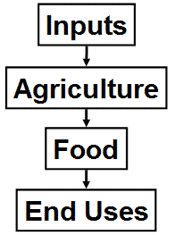35 Food and Agriculture Systems
In Module 2, we learned the importance of a systems perspective for understanding relationships between humanity and the natural environment. We’re going to begin this module by applying this systems perspective to food and agriculture.
The core idea here is to consider all factors that are relevant to food and agriculture. These are our system components. Here is a simple diagram giving a broad overview of food and agriculture systems:

Inputs to agriculture include all of the resources that agriculture draws on in order to succeed. Resource inputs can include natural resources such as air, sunlight, rainwater, and soil nutrients for plant crops, or wild grasses and bodies of water for livestock animals to graze on and drink. Resource inputs can also include artificial resources such as artificial lighting, irrigated water, and synthetic fertilizers for plant crops, or prepared feed and water for livestock animals. Without these inputs, the plants and animals could not grow. Finally, the inputs also include the seeds and parents of the plants and animals, which are of course also necessary for the plants and animals to grow.
The sustainability of inputs is a core aspect of sustainable agriculture. Simply put, if we run out of the resources we need for successful agriculture, then our agriculture cannot be sustained. When agriculture depletes input resources such as water or fossil fuels, then the agriculture is probably unsustainable. But even if inputs are sustained, it is still possible for agriculture to be unsustainable. This is because agriculture impacts other things besides its inputs. Some of these other impacts can render agriculture unsustainable. These other impacts are discussed elsewhere in this module and in other modules.
Agriculture is, in the simplest of terms, the process for converting the inputs into food. Seeds are planted in soil. The soil is fertilized and watered as needed. Plants grow, and they are tended to as needed, such as by keeping pests away. Food from the plants is then harvested and eaten by humans, or fed to livestock animals who are eventually eaten by humans. The eating of food by humans, and in particular the nutrition derived from the eating, is perhaps the core end use of the agriculture. Thus, we can think of food and agriculture as being the process of getting nutrients from the natural environment into human bodies. And it is this. But it is also a lot more.
Throughout the process of getting nutrients from the natural environment into human bodies – that is, from inputs to end uses – there are other important components to the food-agriculture system, components that cannot be defined strictly in terms of nutrients. These include:
- social inputs, including the knowledge about how to conduct agriculture, the labor that performs the agriculture, and policies that facilitate the agriculture;
- the enjoyment of foods that taste good – an enjoyment that comes at least somewhat independently of the food’s nutritional value;
- the socialization that occurs as people share meals together;
- livelihoods achieved by workers in the food and agriculture sectors, which includes everyone from poor subsistence farmers to rich agribusiness executives;
- environmental impacts of growing, transporting, and cooking food, and of uneaten food waste;
- the opportunities for people to do other things given that they have enough to eat.
The social inputs can be considered other inputs in the system diagram shown above. The enjoyment and socialization can be considered other end uses in the diagram. Livelihoods and environmental impacts are other consequences of every component in the diagram. Finally, the opportunities to do other things are consequences of the end uses, in particular, the nutrition: without proper nutrition, we would not have the energy to do anything else with our lives. Thus, the system diagram can be redrawn as follows:

This diagram is not comprehensive. For example, it doesn’t mention the transportation of food from where it’s grown to where it’s prepared to where it’s eaten. So we should not assume that the diagram tells us everything we need to know about the food-agriculture system. But the diagram does give us a reasonable understanding of this system from a particular perspective. Let’s use this understanding to analyze a discussion of food and agriculture.
Reading Assignment: The Global Food System
Please read the article In Corrupt Global Food System, Farmland is the New Gold(link is external).
The article was written by environmental journalist Stephen Leahy(link is external) for the Inter Press Service News Agency(link is external) (IPS). Leahy and IPS are useful resources for learning more about sustainability and global affairs.
As you read the article, think about how it relates to the systems diagrams shown above. Also, think about how the article relates to key course concepts such as globalization and ethics, and to the Module 5 discussion about what development is. Finally, identify the core issues being discussed in the article. How would you handle these issues?
This systems perspective is valuable for helping us understand various aspects of food and agriculture. In the remainder of this module, we’ll look at major aspects of the food-agriculture system and, in particular, their connections to global society and the natural environment.

